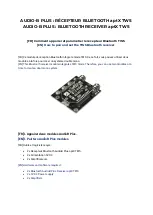
Checking/Adjustment Procedure
1) Play the blank tape (empty tape) and check whether the
guide roller crumbles or wrinkles the tape and adjust it if
necessary.
2) Check that the RF envelope output waveform is flat, and
adjust the height of the guide roller while playing the
standard test tape.
3) Adjust the switching point.
4) Check the RF envelope output is the maximum when
the tracking control locates at the center. If not maxi-
mum, set up to ensure that RF envelope output
becomes the maximum by turning the (+) type driver (Ø
3 ~ Ø 4) on the base A/C groove.
4-18
DECK MECHANISM ADJUSTMENT
8-2. Check of Tape Curl and Jam Status
Fixtures and tools used
Connection position
VCR (VCP) status
Adjustment position
• Oscilloscope
• Standard test tape
(only for SP)
• Post Height Adjusting
Driver
• Driver (+) Type Ø 5
• CH-1: PB RF Envelope
• CH-2: NTSC : SW 30Hz
PAL:SW 25Hz
• Head switching output
point
• RF Envelope output
point
• Play the blank tape.
• Play the standard test
tape.
• Fine adjustment of
guide roller
• Switching Point
• Tracking Preset
• X-distance
7. Adjustment after Drum Assembly (Video Heads)
Purpose of adjustment : To adjust and stabilize the height change, X-distance change, etc
depending on the guide roller after assembling the drum.
RF ENVELOPE OUTPUT POINT
V2
V1
V1
V1/V MAX = 0.7
V1/V MAX = 0.8
RF ENVELOPE OUTPUT
HEAD RF SWITCHING OUTPUT POINT
OSCILLOSCOPE
Connection Diagram
Waveform
CH-2
CH-1
Checking Procedure
1) Check that locking time of the RF and Audio waveform is
fallen within the measuring standard in conversion of the
play mode from the CUE or the REV mode.
2) Readjust the paragraph 5 and 6 if it deviates from the
standard.
Fixtures and tools used
Measuring standard
Connection position
VCR (VCP) status
• Oscilloscope
• 6H 3KHz Color Bar
Standard Test tape
• Stop Watch
• RF Locking Time: Within
5 seconds
• Audio Locking Time :
Within 10 seconds
• CH-1: PB RF Envelope
• CH-2: Audio output
• RF Envelope output
point
• Audio output jack
• Play the 6H 3KHz
Color Bar Standard
Test tape.
8. Check of Traveling Device after Deck Assembly
8-1. Audio, RF Normalization Time (Locking Time) Check in Play after CUE or REV
Checking Procedure
1) Check there is no abnormality of every traveling post
status.
2) There must be no abnormal operation of the counter in
occurrence of folding of the bottom tape. There must be
not abnormality of audio signal in damage of the top tape.
3) If there is abnormality, readjust the adjustment para-
graph 4 and 5.
Fixtures and tools used
Fixtures and tools used
Fixtures and tools used
• T-160 Tape
• T-120 Tape
• There must be no jam or curl at the
first, middle and end position of tape.
• Travel the tape at the position
of its first and end.
Summary of Contents for XBV 443
Page 1: ......
Page 36: ...3 34 3 35 2 POWER SMPS CIRCUIT DIAGRAM 2 SR14301A DVW 7000 DVW 7000 Without...
Page 37: ...3 36 3 37 3 TU IF CIRCUIT DIAGRAM SR14305A DVW 7000 PB REC...
Page 40: ...3 42 3 43 6 JACK CIRCUIT DIAGRAM DVW 7000 Without DVW 7000 Without SR14306A DVW 7000...
Page 44: ...PRINTED CIRCUIT DIAGRAMS 1 MAIN P C BOARD LOCATION GUIDE 3 50 3 51...
Page 45: ...3 52 3 53 2 MAIN P C BOARD LOCATION GUIDE...
Page 62: ......
Page 68: ......
Page 100: ......
Page 106: ......
Page 108: ......
















































